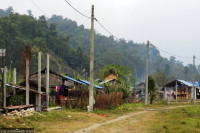National
Nepal signs deal with China to access seven Chinese sea and land ports
Nepal and China on Monday signed the Protocol on Implementing Agreement on Transit and Transport and six other agreements in Beijing after delegation level talks between President Bidya Devi Bhandari and her Chinese counterpart Xi Jinping at the Great Hall of the People.
Anil Giri
Nepal and China on Monday signed the Protocol on Implementing Agreement on Transit and Transport and six other agreements in Beijing after delegation level talks between President Bidya Devi Bhandari and her Chinese counterpart Xi Jinping at the Great Hall of the People.
Minister for Foreign Affairs Pradeep Gyawali and Minister for Transport of China Li Xiaopeng signed the agreement on behalf of their respective governments, according to the Nepali Embassy in Beijing.
The protocol had been pending since Nepal and China signed the Transit and Transportation Agreement in March 2016 during Prime Minister KP Sharma Oli’s visit to the northern neighbour.
The Transit and Transportation Agreement was signed just months after an undeclared Indian border blockade was lifted, with a view to diversifying Nepal’s trade and paving the way for landlocked Nepal to carry out third country trade through ports in the northern neighbour. But for the third-country trade via China to commence, the protocol was a must.
The signing of the protocol makes it possible for Nepal to use four Chinese sea ports—in Tianjin, Shenzhen, Lianyungang and Zhanjiang—and three land ports—in Lanzhou, Lhasa and Shigatse—for third-country import. It will also allow Nepal to carry out exports through six dedicated transit points between Nepal and China.
Experts and officials have argued that access to China’s sea and land ports will help end Nepal’s complete dependence on India for the third-country trade.
However, Rabi Shankar Sainju, who held a series of negotiations with the Chinese side, said that Chinese ports are not a replacement for Indian ports. “They are additional ports which we can use,” Sainju told the Post.
“First, to execute the protocol, we have to upgrade the infrastructure on our side. Second, the protocol allows us all three kinds of services—inland, road and rail. This will help boost investors’ confidence as well.”
Two separate mechanisms, according to officials, will be formed to review and enforce the protocol and resolve technical difficulties that arise during its implementation. Officials said that due to poor infrastructure on the Nepal side, Nepali traders and businessmen will not able to use these Chinese ports immediately.
Currently, only two Nepali entry points—Rasuwagadhi and Tatopani—are being used for trade and business with China.
After the ceremony on Monday, Bhandari and Xi had a luncheon meeting hosted by Zhao Leji, secretary of the Central Commission for Discipline Inspection of the Communist Party of China.
According to the Chinese official news agency, Xinhua, Zhao, a member of the Standing Committee of the Political Bureau of the CPC Central Committee, said the bilateral relations have witnessed rapid development, and the cooperation in various fields has seen steady progress in recent years.
China is willing to work with Nepal to take the Belt and Road Initiative as an opportunity to push forward the China-Nepal comprehensive cooperative partnership with everlasting friendship to a new level, Xinhua quoted Zhao as saying.
Bhandari said Nepal will participate more actively in BRI cooperation, learn from China's experience in state governance, and deepen bilateral cooperation in fields including infrastructure, culture and poverty relief, according to the news agency.
Kathmandu’s proposal of the Nepal-China Trans-Himalayan Multi-Dimensional Connectivity Network, including cross-border railway, was included in the joint communiqué of the second conference of the Belt and Road Initiative, which concluded on Saturday. Even though there are concerns about overcoming the challenges when it comes to bringing the Chinese rail to Kathmandu, the development has renewed optimism in Nepal. On Saturday, Chinese President Xi had expressed his interest to extend cooperation to Nepal.
On Monday, during the delegation level talks, Bhandari extended an invitation to Xi to visit Nepal at a time convenient for him, according to the Nepali Embassy in Beijing.
Bhandari left for China on April 24 in the first state visit by the President of Nepal since the country was declared a republic 11 years ago.
After the meeting, two sides signed six more agreements, according to the Nepali Embassy in Beijing.
Another key agreement was on China’s economic and technical cooperation for Nepal worth Rs16.8 billion (1 billion yuan). Out of the pledged amount, 20 million yuan will be spent for development assistance and to create the headquarters in the 15 northern districts of Nepal. The programme will be executed by the China International Development Cooperation Agency. The rest of the amount will be spent on mutually agreed projects including the expansion of the second phase of the Kathmandu Ring Road.
Revenue Secretary Lal Shanker Ghimire and Wang Xiaotao, chairman of the China International Development Cooperation Agency, signed the agreement on behalf of their respective governments.
Wang had visited Nepal recently and held talks with Prime Minister KP Sharma Oli.
The Nepal government had welcomed the Chinese aid agency to provide development assistance and create capitals in the 15 districts to meet their developmental needs. The districts share the border with China’s Tibet Autonomous Region.
The agency was established in August last year with an aim to strengthen strategic planning and overall coordination of the Chinese aid abroad. Earlier, the Tibetan autonomous government supplied food and other essential goods to Darchula, Bajhang, Humla, Mugu, Dolpa, Mustang, Manang, Gorkha, Dhading, Rasuwa, Sindhupalchok, Dolakha, Solukhumbu, Sankhwasabha and Taplejung.
Other agreements include handing over the certificate of grant-aid for repair and reinforcement of the existing China-aided projects in Nepal, cooperation and mutual administrative assistance in customs matters, cooperation on standardisation between the Nepal Bureau of Standards and Metrology and the Standardization Administration of China and preventing theft, clandestine excavation and illicit import and export of cultural property.




 8.12°C Kathmandu
8.12°C Kathmandu










%20(1).jpg&w=300&height=200)



